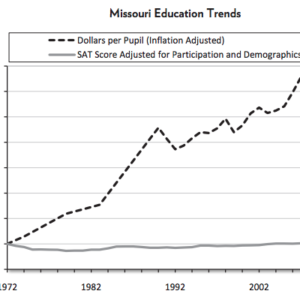School choice opponents flooding media with incorrect information
Over the course of the past week, the same supposedly frightening statistic has mysteriously appeared in three different Missouri news outlets.
On February 15, Jean Dugan, a member of the Webster Groves School Board, claimed in a letter to the editor in the St. Louis Post-Dispatch that tax-payers have wasted more than $620 million since 1999 on 21 failed charter schools.
Surprisingly, Mike Lodewegen, Associate Executive Director for Government Affairs for the Missouri Association of School Administrators, said in a Feb.15 ABC 17 story “Since 1999, 21 schools have closed and we’ve wasted $620 million in state, local, and federal tax dollars.”
And in a Feb. 14 story in the Herald-Whig, Palmyra Superintendent Kirt Malone, used the same talking point to warn his school board of the evils of charter schools.
Of course, what Dugan, Lodewegena, and Malone fail to mention is that that is exactly how charter schools are supposed to work. One of the key tenants of the charter school model is that if they fail to properly educate the children they serve then they, unlike traditional district schools, will be closed.
Dugan, Lodewegena, and Malone also fail to address how much money has been wasted on poorly performing school districts which have operated with little or no consequences for decades while failing to meet their key purpose — adequately educating the children they have been entrusted with.
The closed charter school talking point is far from the only false information being pushed by the education establishment which appears increasingly focused on scaring the public with fake news (a horribly overused term, but the correct one for this situation) in an attempt to protect outdated institutions from the incredible possibilities that school choice could offer to families across Missouri.
For example, while you would assume that an elected school board member would understand state education law, Dugan seems to have no understanding that charter schools are, in fact, public schools just like the schools she is responsible for.
Dugan and Malone also reiterate the misleading talking point that charter schools do not face the same accountability as traditional district schools.
The reality is that charter schools face even greater accountability. They are evaluated on the exact same metrics (including student performance, growth, attendance, graduation rates, and college and career readiness) as district schools. The only difference is that instead of being classified as provisionally accredited or unaccredited if they fail to meet state expectations they can actually be closed which ensures that the students have a chance to attend a better performing school instead of being stuck inside of a failing system for their entire school career.
Dugan also ignores a wealth of highly-respected research (check out this great breakdown by Monica Herk, vice president of education research at the Committee for Economic Development) which shows that not only do charter schools usually improve the performance of students attending them, but they also improve the performance of students attending traditional district schools in close proximity to charter schools.
Then there is the argument put forth in the ABC 17 story that expanding charter schools would result in teachers losing their jobs. How do you think a charter school can teach its children? Yes, expanding public charter schools means that state funding for students who attend those schools will move from the traditional district school to the charter school. And yes, that means that the traditional district school may have to cut staff. But that also means those teachers will have the opportunity to teach in a more open environment, where they have the freedom to use their skills to make creative decisions to provide the best education possible.
Here is what one teacher said this fall after moving to a charter school after 11 years in a traditional school system:
All of this false information has one purpose: to scare the public into thinking that we have to preserve the funding for traditional schools so we can give them a chance to improve.
But there are three hard and very real facts that all of these talking points miss:
 School funding has steadily increased for 40 years, but student performance has remained steady,
School funding has steadily increased for 40 years, but student performance has remained steady,- One in 10 Missouri public school students is trapped in an underperforming school, and
- Only 67% of Missouri children are proficient in English language arts and less than 50% are proficient in math.
If more money and more time are going to lead to better schools, then don’t you think it would have happened by now?
When are we, as a state, going to say enough is enough and give our families and students access to the education choices they deserve?
« Previous Post: GUEST BLOG: A personal experience with IEPs
» Next Post: Students, parents ask legislators for more school choice
